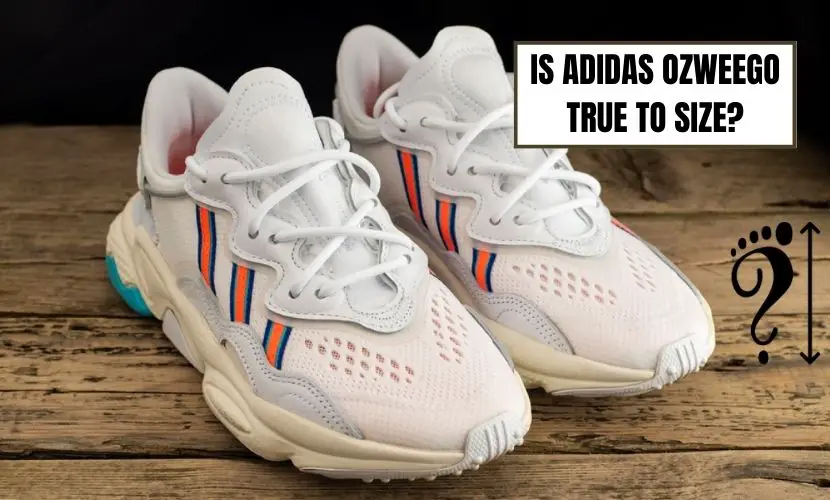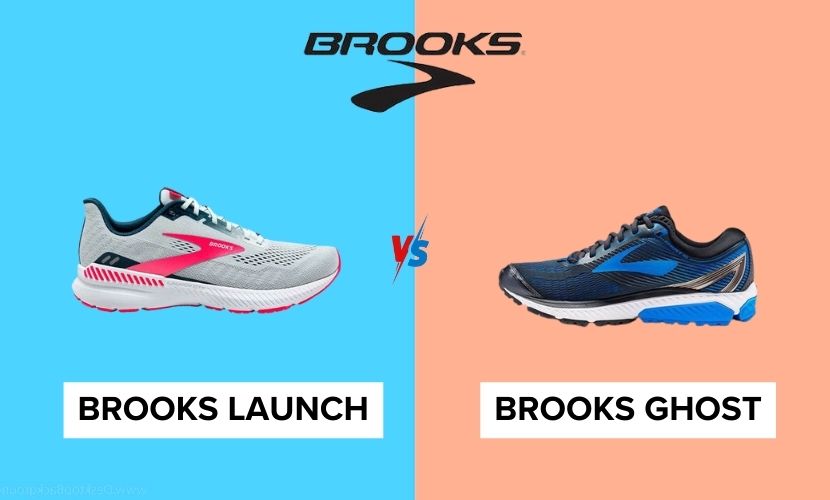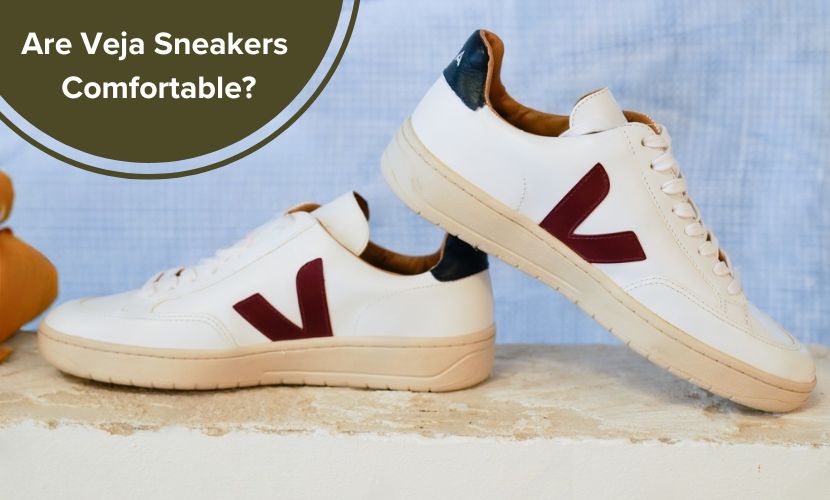Regarding running shoes, Hoka One One is a brand that several athletes trust and count on. Two of their most famous models are the Arahi and the Clifton. On the other hand, both shoes provide a snug and supportive ride, and there are several significant differences between them that players should be aware of before creating a purchase.
One of the chief differences between the Hoka Arahi and Clifton is that the Arahi is a rigid shoe, while the Clifton is a moderate shoe. This shows that the Arahi is structured to offer additional support for overpronators; on the other hand, the Clifton is better matched for runners with a more average gait. The Arahi provides Hoka’s J-Frame technology, constructed to instruct and aid the foot without contributing extraordinary weight or bulk to the shoe.
Another significant dissimilarity between the two shoes is the quantity of padding they offer. The Clifton has a greater stack height and more padding underfoot than the Arahi. However, the Arahi is still a snug shoe with a reactive ride that several runners admire.
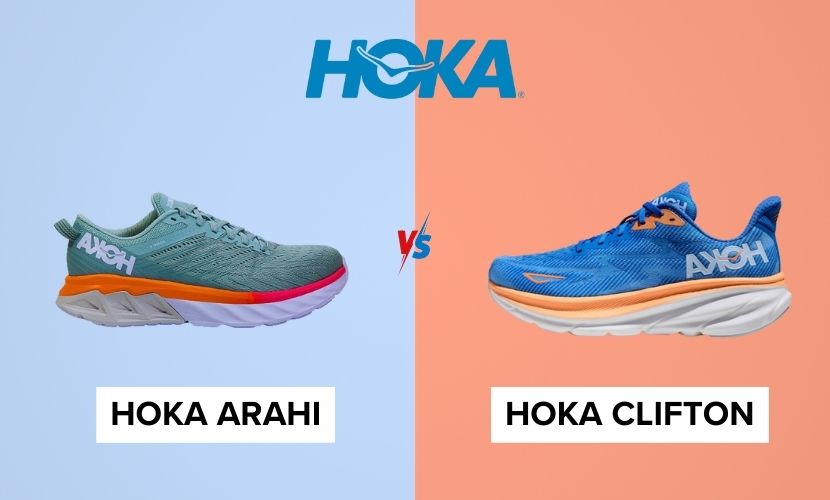
Feature Table: Hoka Arahi Vs Hoka Clifton
| Aspect | Hoka Arahi | Hoka Clifton |
| Shoe Type | Stability/Overpronation | Neutral |
| Cushioning | Firm with J-Frame technology | Soft with EVA midsole |
| Heel Stack Height | 35mm | 29mm |
| Weight | Heavier | Lighter |
| Fit | Snug | Comfortable |
| Support | Extra support for overpronation | Moderate support |
| Ride | Reactive, stable | Soft, cushioned, and stable |
| Ideal For | Overpronators, support seekers | Neutral runners |
| Price | Generally higher | Slightly lower |
Hoka Arahi Overview
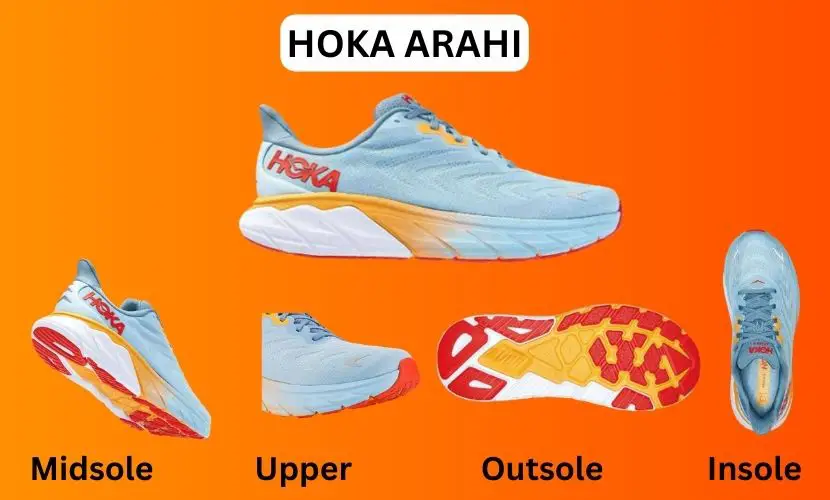
Hoka Arahi is a steady-running shoe structured for overpronators. It is a famous option among runners who require extra support to avert injuries. In this part, we will look deeper at the key attributes, pros, and cons of the Hoka Arahi.
Key Features
The Hoka Arahi offers a J-Frame technology that gives aid and stability to the foot. It is a versatile pattern that wraps around the heel and expands to the midfoot. The J-Frame technology is designed with a rugged EVA foam that prevents the foot from spinning inward. It also contains a Meta-Rocker that provides a smooth ride and aids the foot transition from heel to toe.
The shoe contains a 5mm drop, an average drop for a running shoe. It includes a 29mm stack height in the heel and 24mm in the forefoot, which gives padding and support. The upper is engineered of a porous mesh that maintains the foot cool, fresh, and dry. It also contains a padded tongue and collar for additional comfort.
Pros
- The J-Frame technology features remarkable support for overpronators.
- The Meta-Rocker technology provides an even ride and supports the transition from heel to toe.
- The shoe contains a mild drop, which is adaptable for most runners.
- The upper is absorbent, keeping the foot cool, fresh, and dry.
- The shoe has a hard-wearing outsole that provides remarkable traction.
Cons
- The shoe is more massive than several other running shoes in the industry.
- The padding is more mushy than some other Hoka shoes.
- The shoe may feel too rigid for some runners.
Overall, the Hoka Arahi is a remarkable option for runners who require stability and aid. It has an iconic pattern that offers noteworthy support for overpronators. The shoe contains an average drop and a hard-wearing outsole that provides outstanding traction. However, it may feel too hard for some athletes, and the cushioning could be more squishy than other Hoka shoes.
Hoka Clifton Overview
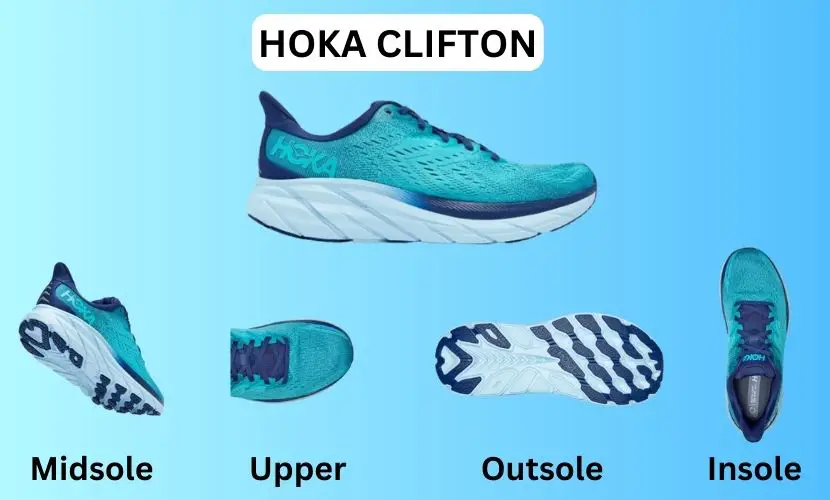
The Hoka Clifton is a trendy running shoe structured for runners who need a snug and feathery shoe that can control short and long distances. It is famous for its opulent cushioning and smooth ride, making it a fantastic option for athletes needing a shoe that offers ease and support.
Key Features
The Hoka Clifton is stuffed with attributes that make it a top-runner option. A few of its essential characteristics include:
- Plush cushioning: The Clifton offers a massive membrane of padding that gives a comfortable and reactive ride.
- Lightweight design: Despite its broad cushioning, the Clifton is surprisingly delicate, making it easy to wear for extended periods.
- Balanced ride: The shoe has been engineered to give a flat ride, having a 5mm drop and a reactive feel that can control a diversity of distinct running styles.
- Durable construction: The Clifton is constructed from top-quality materials structured to last, even with daily use.
Pros and Cons
Like any running shoe, the Hoka Clifton contains its advantages and disadvantages. The following are several most remarkable:
Pros
- Luxurious padding gives a snug and responsive ride
- The feathery pattern makes it comfortable to wear for long periods
- The stabilized ride can handle a diversity of various running styles
- Hard-wearing construction verifies the shoe will last
Cons
- Some athletes may discover the shoe needs to be more padded, impacting their running style.
- The shoe’s extensive pattern may not be ideal for runners with tight feet
- The cost point is more significant than some other running shoes in the industry
Material Comparison
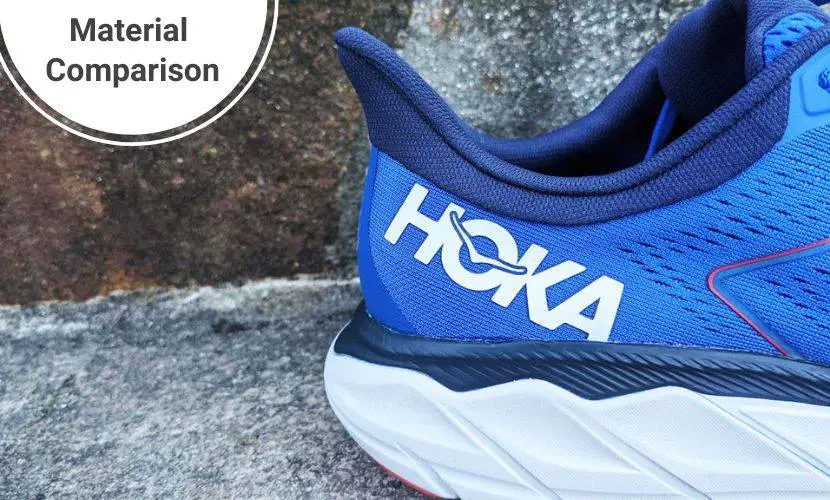
Upper
The Hoka Arahi 6 and Clifton 8 contain distinct uppers. The Arahi 6 offers a more customary engineered netting upper with a rugged structure; conversely, the Clifton 8 has a more porous and delicate mesh upper. Both shoes contain a cushioned tongue and collar for extra comfort.
Midsole
The most remarkable difference lies in the midsole of the Hoka Arahi 6 and Clifton 8. The Arahi 6 provides Hoka’s J-Frame technology, structured to offer steady support for overpronators. The midsole is an amalgamation of EVA and rubberized foam, which provides a sturdy ride.
The Clifton 8, on the other side, has a whole-length EVA midsole with Hoka’s Meta-Rocker technology, which is constructed to offer a smooth and reactive ride. The Clifton 8 also contains a beveled heel, which aids in encouraging a more natural gait.
Outsole
The outsole of the Hoka Arahi 6 and Clifton 8 is designed of durable rubber. The Arahi 6 contains a more customary outsole with a smooth surface area, and on the other hand, the Clifton 8 has a more bent outsole having a beveled heel. The Clifton 8 also contains a broader base, which gives additional stability.
In conclusion, the Hoka Arahi 6 and Clifton 8 have distinct materials in their upper, midsole, and outsole. The Arahi 6 contains a more traditional manufactured netting upper and a rugged midsole with J-Frame technology; on the contrary, the Clifton 8 includes a more absorbent and feathery mesh upper, a whole-length EVA midsole having Meta-Rocker technology, and an extensive curved outsole containing a beveled heel. The selection between the two shoes is based on the runner’s requirements and needs.
Detailed Comparison
Comfort
Regarding comfort, both Hoka Arahi and Clifton provide a comfortable fit. However, the Arahi gives more padding with a 35 mm heel stack height contrasted to 29 mm for the Clifton. This additional padding might be advantageous for runners who require more aid and comfort.
Another dissimilarity between the two shoes is the upper material. The Arahi offers a more permeable netting upper; on the contrary, the Clifton has a more customary engineered tracery upper. This difference might be efficient for runners prioritizing a particular upper material.
Durability
The durability of a running shoe is a necessary factor to examine. Both the Hoka Arahi and Clifton are designed with top-quality materials constructed to last.
However, the Clifton has a more hard-wearing outsole than the Arahi. The Clifton’s outsole is created of a more long-lasting rubber material, which might be advantageous for athletes who put a lot of miles on their shoes.
Performance
The most incredible difference between the Hoka Arahi and Clifton is the stability. The Arahi is a steady shoe; conversely, the Clifton is a neutral shoe. This shows that the Arahi is structured to offer extra aid and stability for overpronators; conversely, the Clifton is manufactured for runners with an average gait.
In the matter of weight, the Clifton is more feathery than the Arahi, containing 0.8 oz/22 g less for the men’s edition. This dissimilarity might not be efficient for several runners, but it might be obligatory for those who prioritize a lighter shoe.
Finally, both shoes contain a 5 mm drop, which might benefit runners prioritizing a deeper depth.
Overall, the Hoka Arahi and Clifton are fantastic running shoes but contain various characteristics that might be ideal for distinct runners.
Sizing Comparison
Size Chart Of Hoka Arahi
The Hoka Arahi has a graded fit and is accessible in both men’s and women’s sizes. It is suggested to go half a size up from your standard shoe size for a snug fit. The table below shows the size chart for the Hoka Arahi:
| US Size | UK Size | EU Size |
| 7 | 6 | 40 |
| 7.5 | 6.5 | 40 2/3 |
| 8 | 7 | 41 1/3 |
| 8.5 | 7.5 | 42 |
| 9 | 8 | 42 2/3 |
| 9.5 | 8.5 | 43 1/3 |
| 10 | 9 | 44 |
| 10.5 | 9.5 | 44 2/3 |
| 11 | 10 | 45 1/3 |
| 11.5 | 10.5 | 46 |
| 12 | 11 | 46 2/3 |
| 12.5 | 11.5 | 47 1/3 |
| 13 | 12 | 48 |
| 14 | 13 | 49 1/3 |
| 15 | 14 | 50 2/3 |
Size Chart Of Hoka Clifton
The Hoka Clifton also has a standard fit and is available in men’s and women’s sizes. It is suggested to go half a size up from your routine shoe size for a snug fit. The table below shows the size chart for the Hoka Clifton:
| US Size | UK Size | EU Size |
| 7 | 6 | 40 |
| 7.5 | 6.5 | 40 2/3 |
| 8 | 7 | 41 1/3 |
| 8.5 | 7.5 | 42 |
| 9 | 8 | 42 2/3 |
| 9.5 | 8.5 | 43 1/3 |
| 10 | 9 | 44 |
| 10.5 | 9.5 | 44 2/3 |
| 11 | 10 | 45 1/3 |
| 11.5 | 10.5 | 46 |
| 12 | 11 | 46 2/3 |
| 12.5 | 11.5 | 47 1/3 |
| 13 | 12 | 48 |
| 14 | 13 | 49 1/3 |
| 15 | 14 | 50 2/3 |
Both the Hoka Arahi and the Hoka Clifton contain a standard fit and are accessible in various sizes. It is suggested to go half a size up from your typical shoe size to verify a snug fit. When selecting the two models, the sizing should be a minor factor, as they both contain similar size tables.
Price
Concerning the price, the Hoka Arahi and Clifton are similarly costed. Both shoes are considered in the mid-extent price point for running shoes. The Arahi generally retails for around $140; on the contrary, the Clifton is costed moderately lower at about $130.
While the cost point may be similar, mentioning that both shoes provide various attributes and advantages is efficient. The Arahi is structured for runners who require stability and aid, while the Clifton is engineered for runners who need a lightweight, padded shoe.
It’s also worth mentioning that the price of these shoes may differ based on the retailer and any sales or advertisements that are currently accessible. Shopping around and contrasting prices before hitting the jackpot is always perfect.
Overall, both the Hoka Arahi and Clifton provide good value for their cost point, with every shoe catering to distinct kinds of runners.
What are the differences between Hoka Arahi and Clifton?
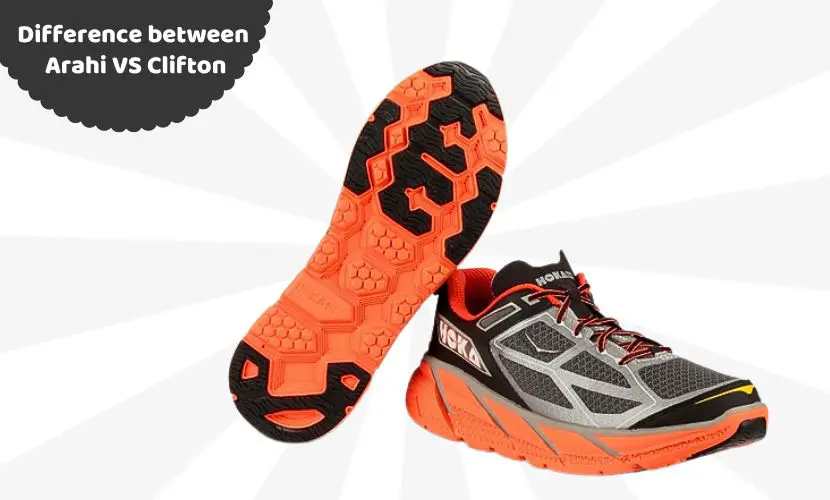
Hoka Arahi and Clifton are two famous running shoes from Hoka One One. On the other hand, both shoes are structured to offer ease and support during running, and they have several significant dissimilarities that separate them.
Stability vs. Neutral
The most significant difference between the Hoka Arahi and Clifton is that the former is a steady shoe; on the other hand, the latter is a moderate shoe. This shows that the Arahi is manufactured to offer additional support for overpronators; conversely, the Clifton is more adaptable for runners with a moderate gait.
Cushioning and Ride
Another significant difference between the two shoes is the standard of padding and riding. The Hoka Arahi provides more cushioning having a 35 mm heel stack height contrasted to the 29 mm for the Clifton. The drop of both shoes is 5 mm. The Clifton is a bit feathery than the Arahi, containing 0.8 oz/22 g less for the men’s version.
Fit and Comfort
The Hoka Arahi and Clifton contain distinct fits and levels of ease. The Arahi feels a bit comfortable around the heel and forefoot, which aids in maintaining the feet in position without leading to much discomfort. Conversely, the Clifton contains a more relaxed fit, which some athletes may discover more snugly.
Price
The Hoka Arahi and Clifton also vary in price. The Arahi is typically more costly than the Clifton, which may be a consideration for several athletes.
In conclusion, the Hoka Arahi and Clifton are remarkable running shoes, but they have efficient differences that make them ideal for distinct kinds of runners. The Arahi is a steady shoe with more padding; on the contrary, the Clifton is a moderate shoe with a more relaxed fit.
Hoka Arahi 6 vs. Clifton 8

The Hoka Arahi 6 and Clifton 8 are two famous running shoes from Hoka One One. On the other hand, both shoes contain several similarities, but they also have some obligatory differences that athletes should consider before hitting the mark.
Cushioning and Ride
The Hoka Arahi 6 provides more padding with a 35 mm heel stack height contrasted to 29 mm for the Clifton 8. The Arahi also contains a sturdy midsole, which gives a more stable and reactive ride. The Clifton 8 has a mushier midsole that provides an opulent and padded ride.
Weight
The weight of a running shoe can influence a runner’s performance, and the Hoka Arahi 6 and Clifton 8 contain few differences in this matter. The Clifton 8 is more delicate than the Arahi 6, with 0.8 oz/22 g less for the men’s edition.
Support and Stability
The Hoka Arahi 6 is a steady shoe structured for runners who overpronate; on the other side, the Clifton 8 is an average shoe. The Arahi 6 contains a J-Frame around the inner and back soles of the shoe, which gives additional support and firmness for overpronators. In comparison, the Clifton 8 includes a stabilized pattern that provides an even and natural ride for moderate runners.
Fit and Comfort
Both shoes have a similar fit and are snug, but the Arahi 6 may feel moderately narrower because of its firmer midsole. The Clifton 8 has a broader toe box, which can be faster for runners with extensive feet.
In conclusion, the Hoka Arahi 6 and Clifton 8 are remarkable running shoes, but their differences make them better matched for different runners. The Arahi 6 is a firm shoe that offers additional aid and stability for overpronators; on the contrary, the Clifton 8 is an average shoe that provides a luxurious and padded ride.
Hoka Arahi 5 vs. Clifton 6
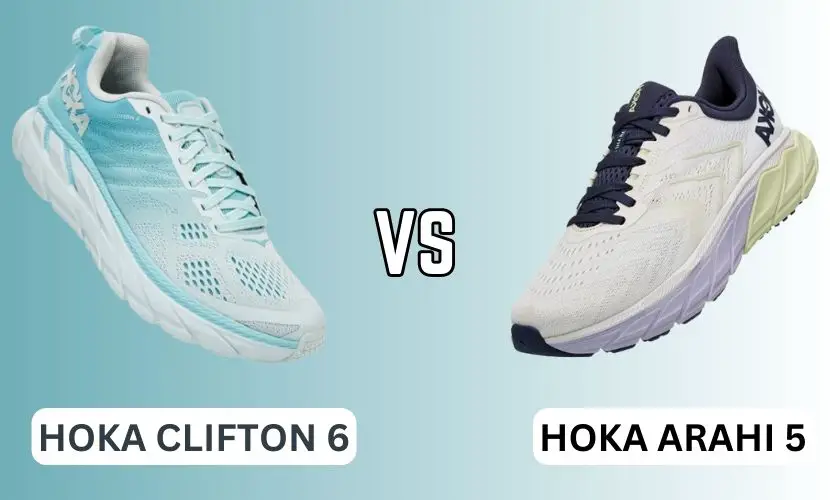
Several significant differences exist when contrasting the Hoka Arahi 5 and Clifton 6. Both shoes are famous options among runners, but they contain distinct attributes that create them better matched for different kinds of runners.
Design and Fit
The Hoka Arahi 5 is a steady shoe for runners requiring additional support. It provides a J-Frame technology that offers a stable ride and aids in averting overpronation. The upper of the Arahi 5 is designed of manufactured mesh, which gives permeability and a snug fit.
On the other hand, the Hoka Clifton 6 is an average shoe with a stabilized ride. It contains a delicate and absorbent upper made of engineered tracery. The Clifton 6 also includes a spacious toe box, which permits natural foot movement and supports preventing injuries.
Cushioning and Ride
The Hoka Arahi 5 contains a 5mm drop and a 29mm heel stack height, which gives moderate cushioning. The shoe also includes a more rugged feel than the Clifton 6, making it accurately suited for runners prioritizing a more reactive ride.
The Hoka Clifton 6, on the other side, contains a 5mm drop and a 29mm heel stack height. Thanks to its whole-length EVA midsole, it provides an opulent and snug ride. The Clifton 6 is also more delicate than the Arahi 5, making it a good option for runners who prefer speed.
Durability and Price
Both shoes are hard-wearing and can resist high mileage. However, the Hoka Arahi 5 contains a more robust pattern, making it better matched for runners requiring additional support and steadiness. The Hoka Clifton 6, on the other side, has a more unembellished design, which generates it feathery and more stretchable.
Regarding price, the Hoka Arahi 5 is moderately more costly than the Clifton 6. However, both shoes are equitably priced and provide excellent value for money.
Overall, the Hoka Arahi 5 and Clifton 6 are remarkable running shoes with different attributes. The Arahi 5 is better matched for runners who require additional aid and stability; conversely, the Clifton 6 is better suited for athletes who prefer speed and ease.
Hoka Arahi 5 vs. Clifton 7
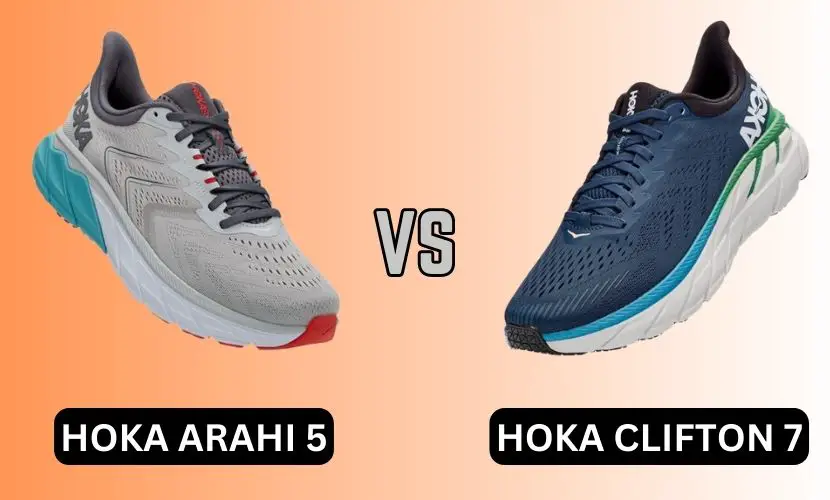
Concerning Hoka’s running shoes, Arahi and Clifton are two of the most renowned models. The Hoka Arahi 5 and Clifton 7 are the newest editions of these shoes. The following is how they contrast:
Cushioning and Ride
Thanks to its whole-length EVA midsole, the Hoka Clifton 7 contains a mushier ride than the Arahi 5. The Clifton 7 also includes a greater stack height than the Arahi 5, which shows it gives more padding. However, the Arahi 5 has a rugged ride because of its J-Frame technology, which offers extra support and firmness.
Weight and Fit
The Hoka Arahi 5 is moderately more massive than the Clifton 7, but it still feels delicate on the foot. Both shoes contain a similar fit, with a roomy toe box and a comfortable midfoot. However, the Arahi 5 includes a slightly tighter heel than the Clifton 7, which may impact the fit for several runners.
Arch Support and Stability
The Hoka Arahi 5 is a steady shoe structured for runners who overpronate. It provides Hoka’s J-Frame technology, which offers additional support and firmness. The Clifton 7, on the other side, is a neutral shoe engineered for runners with a moderate gait. It has a different level of aid and stability than the Arahi 5.
In conclusion, the Hoka Arahi 5 and Clifton 7 are outstanding running shoes but serve distinct purposes. The Arahi 5 is a firm shoe manufactured for athletes who overpronate, while the Clifton 7 is an average shoe constructed for runners having a neutral gait. Selecting the perfect shoe inclines on your running style and requirements.
Hoka Arahi Vs. Clifton: Which is comfortable for long-distance running?
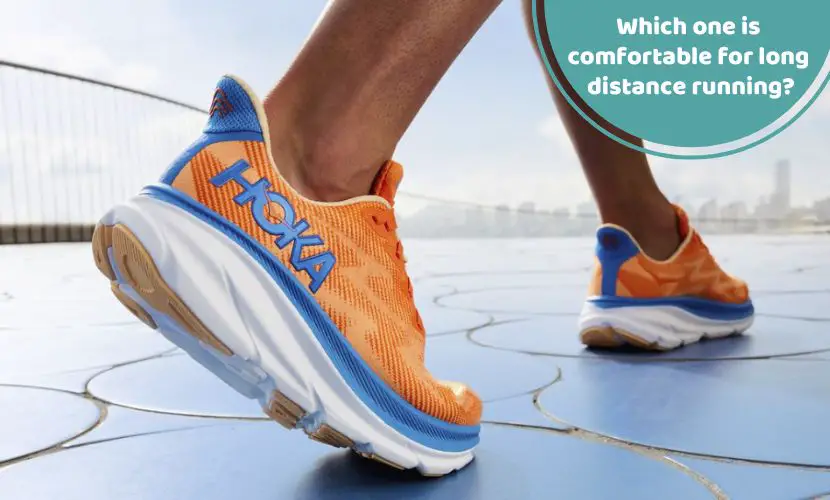
Regarding long-distance running, ease is critical. The Hoka Arahi and Clifton are famous for their padding and aid, but which is more comfortable for long distances?
The Hoka Arahi is a firm shoe engineered for overpronators, which shows it gives additional support to those who require it. It offers a J-Frame design that aids the foot in an innate gait cycle, lessening the possibility of injury. The Arahi also has a 35 mm heel stack height, making it a perfect option for runners requiring more padding.
Conversely, the Hoka Clifton is a moderate shoe that is more delicate than the Arahi, having 0.8 oz/22 g less for the men’s version. It contains a 29 mm heel stack height, which is still quite tremendous and gives adequate cushioning. The Clifton is famous for its stabilized ride, which shows it is adaptable for many runners.
In the case of comfort for extended-distance running, both shoes contain their advantages and disadvantages. The Arahi’s additional support and padding may be advantageous for runners with overpronation or those who require more padding. However, Clifton’s feathery weight and stabilized ride may be more snug for runners prioritizing a more natural feel.
Hoka Arahi Vs. Clifton: Which shoe provides the most support?
Concerning support, Hoka Arahi and Clifton have several significant differences. The Arahi is structured mainly for overpronators; on the contrary, the Clifton is a moderate shoe that gives less support.
The Arahi contains a J-Frame technology that supports the foot and aids handle overpronation. This technique is a sturdy density foam that covers around the heel and elongates through the midfoot. It works by instructing the foot into a natural motion, on the other side, still giving support. This makes the Arahi a fantastic choice for runners requiring additional support and steadiness.
Conversely, the Clifton contains a mushier midsole and less structure, offering less support than the Arahi. However, it still provides a snug ride and is an excellent choice for runners who require less approval.
Regarding weight, the Clifton is more delicate than the Arahi, which may be a factor for several runners. The Clifton also contains a moderately more profound heel-to-toe drop than the Arahi, which may attract runners who prioritize a more natural feel.
Overall, the Hoka Arahi is the finer choice for runners who require additional support and firmness because of overpronation; on the contrary, the Clifton is a perfect option for runners who don’t need as much aid.
Conclusion
Both the Hoka Arahi and Clifton are remarkable running shoes that adapt to distinct kinds of runners. The Clifton is a moderate shoe with adequate padding and is ideal for runners prioritizing a mushier ride. Conversely, the Arahi is a firm shoe with more reactive padding and is perfect for runners who require additional support.
In the case of weight, the Clifton is more delicate than the Arahi, which may be a determining factor for several athletes. However, the Arahi provides more padding with a greater heel stack height than the Clifton. The drop of both shoes is approximately 5mm, which is adaptable for most athletes.
The curvature of the shoe is also a spike of differentiation between the two designs. The Clifton has a more fabulous spring contrasted with the Arahi, which may be a factor for athletes who prioritize a shoe with a more excellent heel and toe off the ground.
Eventually, the selection between the Hoka Arahi and Clifton depends on individual requirements and running style. Runners who prioritize a neutral shoe with a squishier ride would likely go for the Clifton; on the contrary, runners who require additional support and more reactive padding would probably select the Arahi. Both shoes are remarkable and worth considering for any athlete searching for a high-standard running shoe.
Read more on:

